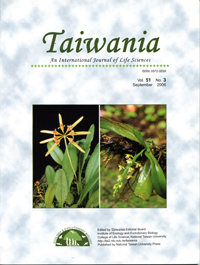Research Paper
Ultrastructure of Spermatogenesis of the Paradise Fish, Macropodus opercularis
Tsung-Han Lee, Ting-Hsuan Chiang, Bu-Miin Huang, Tung-Cheng Wang and Hsi-Yuan Yang
Published on: September 2006
Page: 170 - 180
DOI: 10.6165/tai.2006.51(3).170
Abstract
The intricate process of spermatogenesis in the paradise fish, Macropodus opercularis, was studied. In this species, the unrestricted or lobular type testes lining the caudal side of the body cavity are translucent and slender. Spermatogonia occur along the length of the tubules and the development of sperm takes place within cysts formed by Sertoli cells. Spermiogenesis involves preparatory morphological events followed by conspicuous modifications such as the movement of the centrioles, completion of the nuclear condensation, reduction of the cytoplasm, and the final differentiation of the flagellar complex. Mature spermatozoon has an oval nucleus, condensed chromatin, and typical 9 + 2 flagellar axoneme but lack acrosome. The role of the material in the nucleus and the cytoplasm as it reaches the Sertoli cell in the control of spermatogenesis is discussed.
中文摘要
報告中我們以蓋斑鬥魚 (Macropodus opercularis) 精子生成做組織學上的精微探 究。此物種之精巢組織構造為小葉狀形式、外觀呈半透明之細長狀器官,緊貼於近尾端之體腔側壁。精細胞分布於細精管內側,並以支持細胞環繞而成的囊胞為發育單位。精子形變包括許多形態上的顯著改變,如中心粒的位移、細胞核的濃縮、細胞質的減少和鞭毛構造的形成。成熟精子的細胞核為卵圓形,內含有濃縮後的染色質,鞭毛中有典型的9 + 2 微管結構但無頂體。文中也對精子發育過程中細胞核質與細胞質胞器所扮演的角色有所討論。
Keyword: Paradise fish, Testis, Ultrastructure, Spermatogenesis.


